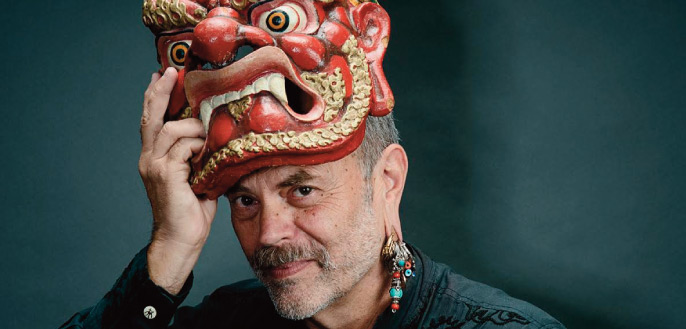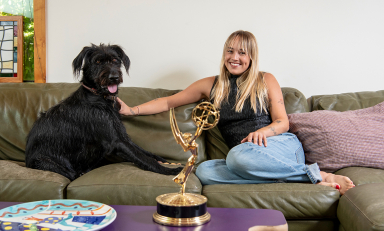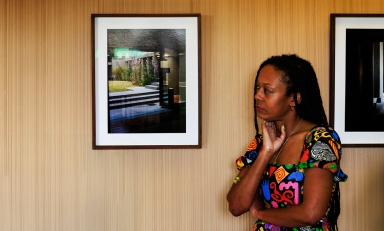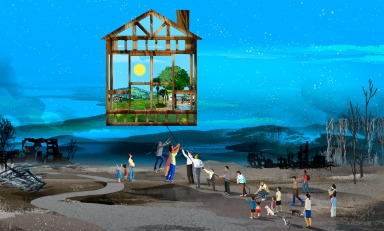
Imagineer is a job title that manages to sound anachronistic, futuristic, and magical all at once. What sort of boutique concern could create such a position? Disney, of course. Walt Disney Imagineering, to be exact, which the Los Angeles Times recently characterized as “the company’s highly secretive arm devoted to theme park experiences.”
And if there’s one man who knows the secrets, perhaps the Imagineer ne plus ultra, it’s Joe Rohde ’77. Disney’s executive designer and vice president of creative. He was the lead designer for Disney’s Animal Kingdom, the zoological theme park in Bay Lake, Fla. He helmed the design team for Oahu’s beachside complex Aulani, a Disney Resort & Spa. Most recently, he was behind the transformation of the Twilight Zone Tower of Terror ride into Guardians of the Galaxy: Mission Breakout at California Adventure, as well as the creative director for Animal Kingdom’s Pandora—The World of Avatar. Both attractions opened to great acclaim (and long lines) in May.
A conversation with Rohde is a ride unto itself. His knowledge on myriad topics runs deep and wide, and his verbal gifts are astonishing, accented with impulsive gesticulations and a gallery of facial expressions. And there’s his trademark collection of tribal earrings, about a half dozen or so, that he’s worn for years in his left ear, with the distended lobe to prove it.
Rohde frequently asks and answers his own questions, often shifting into the Runyonesque urgency of present tense as he delves into complex theories of design, expounds on the intricacies of story and art, and weaves tales of adventure and wildlife conservation—perhaps his two greatest passions—in remote corners of the globe. If you could hear his brain working, it would be thrumming along like a Wankel rotary engine at full bore.
“The term now is so much more well known, but Imagineering used to be very secretive,” Rohde says in his Burbank office. “It wasn’t a place that spoke about itself, it was not a place that people knew about.”
Thirty-seven years ago, Rohde was one of those people. Soon after graduating from Oxy as an art major, he was teaching theatrical set design at Chaminade College Preparatory School, his high school alma mater in Northridge, assuming he would end up working in theater or film. Then Rohde experienced a life-changing, Lana Turner-at-Schwab’s Drugstore moment.
Longtime Disney vice president of engineering John Zovich’s children were among his students, and Zovich had seen school productions featuring Rohde’s work. “The theater department at the time did not have very big budgets, yet we made these rather impressive, elaborate productions in terms of set and costume design,” he recalls. “So Zovich comes into my office saying, ‘You’re wasting your time here, kid. You should be working for Walt Disney Imagineering.’
“I knew nothing about Walt Disney Imagineering—just nothing,” admits Rohde, who initially “blew off” Zovich. “The Disney Company is never going to hire a person like me—hair and hippie—there’s no way.”
He was wrong. But let’s back up.
Disneyland and Rohde were both born in California in 1955—the theme park, which opened that July, is two months his senior—but at this stage they had little else in common. His parents were both native to the Hawaiian Islands, and took the family back to the homeland when Rohde was 2.
Father Martin was a cameraman, with credits including Blue Hawaii (1961) and The Endless Summer (1966). “If it was a film shot in Hawai‘i, he worked on it,” says Rohde. “He filmed President Kennedy’s visit to Hawai‘i [in June 1963].”
He grew up in Makiki, the same Honolulu neighborhood as another future Oxy high-achiever, Barack Obama ’83. “It was a very working-class, lower-middle-class kind of neighborhood, still is,” Rohde says. “My brother suffered a traumatic brain injury when he was very young, and so my parents never had any money because of medical bills. We lived in this old, vast, decrepit estate house with servants’ quarters and a carriage house that had a carriage in it.” Young Joe found his escape through reading and being “creative.”
The family moved to Los Angeles when Rohde was in junior high as his father followed film and TV work, which included shooting on 1968’s Planet of the Apes. The running-through-the-cornfield scene where the apes hunt down and capture Charlton Heston? That’s Martin Rohde’s footage.
“My dad would take me to work,” Rohde continues. “He’d say, ‘Hey, you’re not going to school today ’cause we’re going to flip a car over. You got to see this. We’re going to crash an airplane, we’re going to blow up a bridge! You got to see this stuff!’”
Back lots and movie ranches became an influential playground for Rohde. “I would just kind of lurk around these places watching how things got done as a kid,” he recalls. On the old 20th Century Fox shooting ranch—what is now Malibu Creek State Park—“I would just wander off on 40,000 acres full of moldering old castles and trains and Davy Crockett forts and Che Guevara villages and that whole weird stone Planet of the Apes city. It was an odd formative experience.”
Facing his next formative learning experience after high school, “Occidental was the only college I applied to,” he says. “I figured I was going to be in the arts, and Oxy had a theater program that was fairly well respected. The work that I do now leverages heavily on the type of liberal arts education that I got from Occidental.”
Rohde mustered his way through college through a mix of grants, scholarships and work. (As a member of the kitchen crew at Oxy, “One of our jobs was pulling the dishes out of the big Hobart dishwashing machine and stacking them to be sent out again for food preparation,” he recalled on Instagram.) In helping art history professor George Goldner prepare his slide shows, “I got this incredibly steeped and distilled art history training on top of the courses I took,” he says.
But it was a climb to reach the work he does now, one that began with the mysterious role of Imagineer in 1980. “I got this super entry-level job at a place I knew nothing about and I didn’t know how to do anything,” Rohde admits of his entrée to Disney. He was tasked with building intricately detailed models that went far beyond the foam-core and Popsicle-stick variety that he was creating as a high school teacher.
“I start out on the Mexico Pavilion, which is at Epcot Center, my very first job,” he recalls. “Luckily I fall into the more sculptural parts of model building that I am quite good at—the faux rocks and ruined pyramids, that kind of stuff.”
Riding the work wave provided by the massive Epcot project at the Walt Disney World Resort, Rohde flexed his skills as a scenic painter, and things began looking up—until Epcot was completed. Facing a layoff, he began farming out his abilities to producers in the company as an illustrator, which brought him to a crucial career nexus. “I get coupled with this guy who’s a very good mentor in design but not a very good speaker.”
Now, Rohde has always been good at speaking. His gift of gab allowed him to leapfrog from the back end of production to the front end of conception. “So all of the training that comes along with a liberal arts education—the critical thinking, the ability to communicate the principle of understanding—all that comes into play and suddenly I’m the talking guy.”
“When Joe talks, it causes the IQ of everybody in the room to go up by 25 points,” says two-time Oscar nominee Bob Rogers, founder and chairman of BRC Imagination Arts, an experience design firm. “He just has this way of making you feel more literate than perhaps you really are, so much better educated than perhaps you really are, because he uses very sophisticated ideas from philosophy and cultural heritage and psychology, but he uses those terms in a way that brings you along and he makes you think you understand them.”
Prior to Animal Kingdom, Rohde’s biggest design creation was a bar called the Adventurer’s Club at Disney World’s Pleasure Island. But when Michael Eisner took over as Disney chairman in 1984, Rohde’s star took off. It may have helped that in an initial pitch meeting with Eisner, Rohde sauntered in with a Bengal tiger in tow—yes, a living, breathing friend of Oswald. That sort of stunt gets you noticed.
“So I get an assignment to do a project that Eisner wants called the Animal Kingdom,” he says. “Nobody wants this job. They don’t believe it’s going to get built, and everyone conceptualizes it in terms of pre-existing phenomena like a zoo. Because of that I am able to get this assignment with a very limited pedigree behind me.”
Breaking ground in 1990, the 580-acre Animal Kingdom, divided into seven themed areas, took eight years to build. With a storytelling message built around animal conservation and nature—not “Once upon a time ”—the park posed a world of challenges and questions, namely, “What does it mean to be Disney inside this thing?” Rohde says. “One of the first premises is we will not be able to use that whole purified, idealized look.”
That Disney aesthetic “implies that I am walking inside of a story that I know,” he adds, with characters and a plot. “That’s not the story of live, wild animals. “They’re caught up in actual action of history, time, and change.”
Attendant with the entertainment factor inherent in the park, there was the subtext message of conservation education. “This required extremely high levels of research and cultural engagement,” says Rohde. “So we set up a culture of deep collaboration with the community of conservation scientists and zoo operators and wildlife conservation people, outside forces with a limited vested interest in our business. And that led to this park, which has a very different look and feel and is, in fact, the epicenter of a global wildlife conservation effort. We have tens of millions in conservation funds dispersed around the world.”
After Pandora—The World of Avatar opened inside Disney’s Animal Kingdom in May, waiting times reportedly stretched up to three hours. The 12-acre sci-fi environment is a recreation of the fictional moon Pandora introduced in director James Cameron’s 2009 megahit Avatar, with attractions such as the Na’vi River Journey and the 3-D ride Flights of Passage (on the back of a flying banshee, no less). The project is a collaboration with Cameron and producer Jon Landau of Lightstorm Entertainment.
“When we first met Joe, he seemed more like a bohemian world traveler than the artist that we discovered him to be,” says Landau, who will begin concurrent production on four Avatar sequels this fall (to be released over five years beginning in 2020). “Joe really looks at the whole picture of things: What are you trying to evoke from the people who are responding to your creation? That’s what we fell in love with about Joe, because that’s the way we look at our films.”
And Rohde—who stresses that the key to successful Imagineering is collaboration—is a fun guy to work for, Landau adds. “The leadership qualities that I saw Joe exemplify were that—at the same time he needed to be bringing people into battle—he would also be the one to go out to dinner with them, pick up a whole fish that had been served and start using it as puppet and singing through it, and making everybody feel so comfortable. Yeah, Joe might be their boss, but you know what? That’s Joe Rohde.”
At an estimated cost of $500 million (more than twice the budget of Avatar), Rohde and his team’s Pandora takes guests into a world of floating mountains, bioluminescent fauna, and extraterrestrial creatures come to life. “Imagine the most complicated architectural job ever being done, coupled with the need to make all of that more richly detailed than any opera set you will ever see,” he says of the almost-six-year project. “That stuff gets hard.”
What guests leave with after experiencing all of this is of paramount concern to Rohde, a tenet that echoes back to Disney himself. “The key thing about Walt that is still operative today is this very high level of respect for the audience,” he says. “You’re intellectually respecting the audience’s capacity to digest story at multiple levels, and to engage at multiple levels, and those change with time and with the product. But the principle is there.”
Although Rohde’s intense research process has taken him and his team to remote parts of China, Katmandu, and the Yucatan Peninsula, “Those are business trips,” he says. “I like real adventure. In the modern world, that takes quite an effort.”
In fall 2013, Rohde and a small crew traveled by horseback to the treacherous Altai Mountains in Western Mongolia on a monthlong expedition to raise funds for the Snow Leopard Conservancy. In the face of blizzard-like conditions and ill-tempered camels, Rohde executed a series of “stupidly large paintings in the field or habitat where one would see the snow leopard under the idea that the leopard and the land are one thing.”
Twenty-five of Rohde’s paintings were exhibited at Ojai’s Primavera Gallery in 2014, and a 59-minute film documenting his “awakening,” The Leopard in the Land, played the festival circuit prior to its home video release in 2015. (All proceeds from the paintings and film benefit the conservancy.)
Rohde gets excited just recounting the Ripleyesque expedition: “I don’t really know where we’re sleeping tonight. What’s going to happen tomorrow? What we know is, we were dropped off here in this valley, we have 29 days to make it to this other valley where we’ll get picked up. … I’m painting in the damn blizzard. I can’t tell you how much I love this!”
This globetrotting romantic, this creator of lands and kingdoms, calls Altadena home. Rohde and his wife, Melody Malmberg ’79, have two sons, Kellan, 23, and Brandt, 20. In Ojai, a couple of hours north, the family has “a little cabin surrounded by open land, and you can hear a lizard walking on a rock,” he says. “It’s the only place I can think of where I’m actually doing kind of nothing.”
Doing nothing, even kind of, is a rarity for Rohde. “I find myself quite busy,” he says of his Disney work. “There is no other creative discipline that comes close to the complexity and technical challenge of what we do. There are a thousand things to be done that have never been done before—and that’s really interesting to me. You have to surprise people.
“The architecture of my career—how it works, how I am able to do all of this stuff—is this: The application of classic, thematic, literary theory to the entire human enterprise of large-scale ensemble design,” he says. “One can go on and on, but all that Occidental stuff comes home every single day. Every single day.”
Photo by Max S. Gerber. Peter Gilstrap wrote “Organ Recovery” in the Spring issue.



